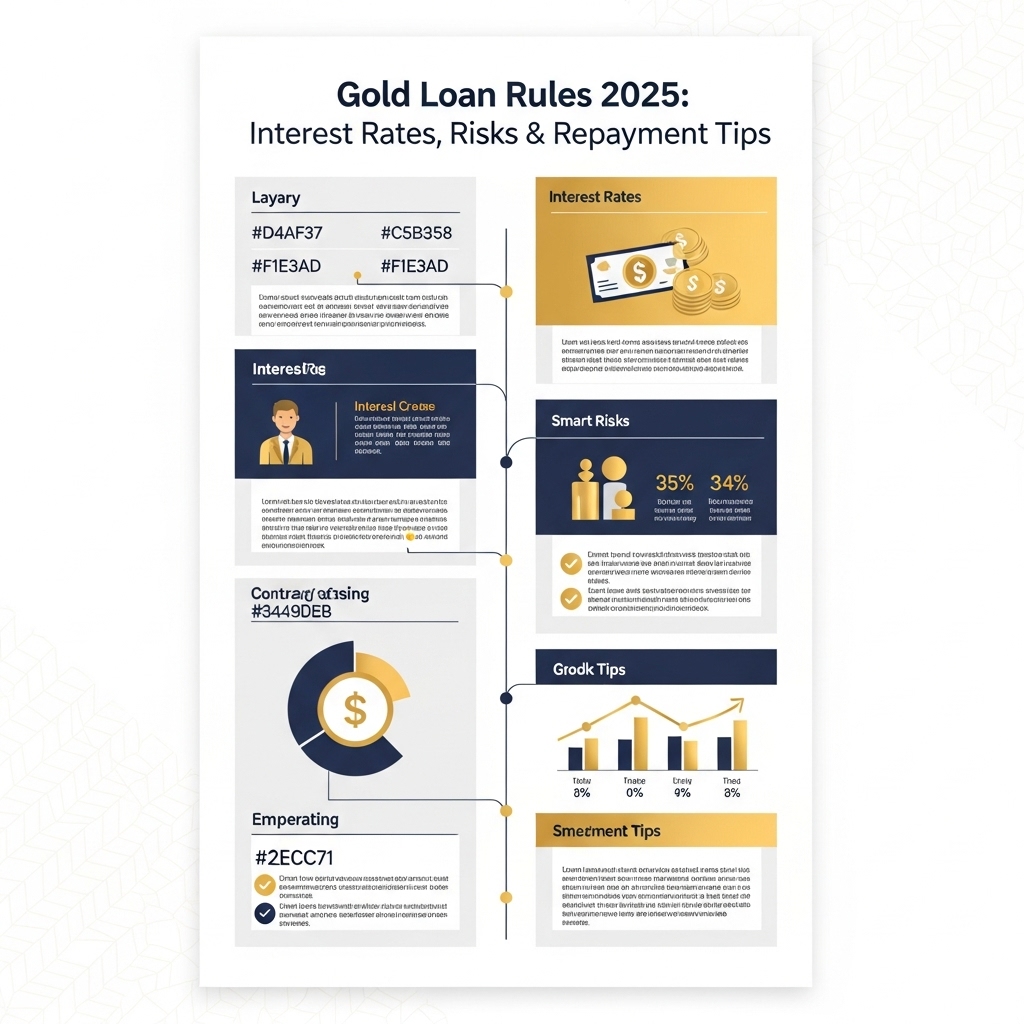Gold Loan Rules 2025: Navigating Your Gold-Backed Financial Future
Gold isn’t just a shiny asset; it’s a financial powerhouse. As 2024 continues to see gold prices soar, consistently hitting new benchmarks and reinforcing its status as a premier safe-haven, savvy investors are increasingly recognizing its dual potential: not only as a long-term store of value but also as a powerful source of immediate liquidity. While physical gold and ETFs form the bedrock of a robust portfolio, the challenge often lies in accessing its inherent value without liquidation. This is precisely where understanding gold loans becomes invaluable. For the astute gold investor, leveraging your existing gold through a loan offers a strategic pathway to secure liquidity for diverse financial needs – from seizing new investment opportunities to managing unforeseen expenses – transforming a static asset into a dynamic financial tool that continues to appreciate.
To confidently navigate this sophisticated financial avenue, staying informed about evolving regulations and market dynamics is paramount. This comprehensive guide delves into the anticipated ‘Gold Loan Rules 2025’. We’ll meticulously explore everything you need to know about competitive interest rates, the critical risks involved, and expert repayment tips. Our aim is to empower you with the knowledge to make informed decisions, ensuring you maximize the financial benefits and safeguard your cherished gold investments for the future.
Gold Market Analysis and Key Insights
The role of gold as a foundational asset in investment portfolios remains significant, particularly as global economic landscapes evolve towards 2025. Understanding its market dynamics is crucial for investors considering gold, whether directly or through gold-backed instruments. Its unique characteristics offer distinct advantages, though careful consideration of its nature is essential.
Gold as a Safe Haven Asset
Gold consistently performs as a safe haven asset during periods of economic uncertainty, geopolitical instability, and financial market volatility. Its inverse relationship with the dollar and traditional equities often makes it an attractive refuge when other asset classes falter. Investors tend to flock to gold during crises, seeking to preserve capital, a trend expected to continue given the current global climate.
Inflation Hedge Capabilities
With persistent inflation concerns globally, gold’s historical role as a hedge against rising prices is gaining renewed attention. As the purchasing power of fiat currencies erodes, gold often maintains or increases its value, offering protection against inflationary pressures. This makes it a vital component for long-term wealth preservation, especially in an era of expansive monetary policies.
Portfolio Diversification
Including gold in an investment portfolio can significantly enhance diversification. Its low correlation with stocks, bonds, and real estate helps mitigate overall portfolio risk. During market downturns, gold’s stability can offset losses in other assets, leading to a more resilient and balanced investment strategy that withstands various economic cycles.
Current Gold Market Trends and Data: The gold market has witnessed considerable upward momentum in recent years, reaching historic highs driven by aggressive central bank gold purchases, geopolitical tensions, and expectations of interest rate cuts. While some volatility is inherent, the underlying demand from both institutional and retail investors suggests a robust long-term outlook. Data indicates continued interest in gold, supported by global economic shifts and a search for tangible assets.
Investment Benefits and Considerations: Investing in gold offers benefits like liquidity, tangibility, and a lack of counterparty risk. However, it’s crucial to consider that gold does not yield income (like dividends or interest) and can incur storage or insurance costs for physical holdings. Price volatility, while offering potential gains, also presents risks.
Expert Recommendations: Financial experts generally advise a modest allocation to gold, typically 5-15% of a diversified portfolio, as a strategic long-term hold rather than a speculative short-term trade. This approach leverages its safe-haven and diversification benefits without over-exposing the portfolio to its unique risks, promoting a balanced and stable investment strategy.

Gold Investment Strategies and Options
While gold loans are primarily a borrowing tool, understanding broader gold investment strategies can inform your decisions. Several avenues exist for investing in gold, each with varying risk profiles and potential returns.
Physical Gold: This includes buying gold coins, bars, or jewelry. It offers tangible ownership but incurs making charges, storage costs, and risks of theft or damage. Strategies involve buying during price dips or as a hedge against inflation.
Gold Exchange-Traded Funds (ETFs): These are popular for their liquidity and ease of trading on stock exchanges. They track the price of gold and offer a low-cost way to gain exposure without physical possession. Portfolio allocation should consider gold ETFs as a diversification tool, typically ranging from 5-15% of a balanced portfolio, depending on risk tolerance.
Sovereign Gold Bonds (SGBs): Issued by the government, SGBs offer a fixed interest rate on the invested amount and are linked to gold prices. They are considered a relatively safe option with tax benefits on capital gains upon maturity. Strategies include holding them for the long term to benefit from both price appreciation and interest income.
Gold Mining Stocks/Funds: Investing in companies that mine gold can offer leverage to gold prices, but also introduces company-specific risks. This is a higher-risk, higher-reward strategy.
Comparison: Physical gold offers direct ownership but is less liquid and costlier to maintain. ETFs provide liquidity and ease of management. SGBs offer interest and tax benefits but have longer lock-in periods. Mining stocks are volatile.
Market Timing: While often difficult to predict, buying gold during periods of economic uncertainty, geopolitical instability, or high inflation can be strategic. However, a long-term buy-and-hold approach, or dollar-cost averaging, often mitigates timing risks. For gold loans, this translates to considering loan-to-value ratios when gold prices are anticipated to rise.
Market Performance and Outlook
Historically, gold has demonstrated its resilience as a safe-haven asset, performing robustly during periods of economic uncertainty and inflation. For instance, post-2008 and during the COVID-19 pandemic, gold prices saw significant appreciation, underscoring its role in stabilizing asset-backed loans like gold loans. This intrinsic stability has made gold loans increasingly attractive due to reduced collateral risk for lenders and accessibility for borrowers.
Currently, the market sees gold prices at elevated levels, primarily driven by persistent global inflation concerns, geopolitical tensions, and fluctuating interest rate expectations. This environment strengthens the value of gold collateral, contributing to a robust gold loan market characterized by increasing demand and competitive interest rates from both banks and NBFCs. The sector is experiencing healthy growth, driven by its quick disbursement and minimal documentation.
Looking ahead to 2025, the outlook for gold remains cautiously optimistic. Continued economic uncertainties, potential currency devaluations, and sustained central bank gold purchases could provide further upward price momentum. Conversely, a rapid global economic recovery or aggressive interest rate hikes might temper gains. For the gold loan sector, this translates into sustained growth, especially as formal financial inclusion expands and digital processes streamline access. The ‘Gold Loan Rules 2025’ will likely contribute to market clarity and stability, fostering a more organized and trustworthy lending environment.
Frequently Asked Questions About Gold Investment
What is a gold loan and how does it work in 2025?
A gold loan allows borrowing funds by pledging your gold (ornaments, coins, bars) as collateral. Lenders assess purity and weight to determine the loan amount, offering quick liquidity based on market value.
What are the typical interest rates for gold loans expected in 2025?
Interest rates in 2025 will vary by lender and loan terms, generally ranging from 7% to 29% annually. Always compare offers from banks and NBFCs to secure the most competitive rate.
What are the primary risks associated with taking a gold loan?
The main risk is losing your pledged gold if repayment defaults. Gold price fluctuations can also affect the loan-to-value ratio, potentially requiring additional collateral or payments.
What are effective repayment strategies for a gold loan?
Prioritize timely payments to avoid penalties. Consider flexible options like bullet repayment (principal at maturity) or EMIs. Partial pre-payments, when possible, reduce your overall interest burden.
What type of gold can I pledge for a loan?
Most lenders accept gold ornaments, jewelry, gold coins, and bars of specific purity (typically 18-24 carats). Hallmarked gold is generally preferred for a better valuation.
What happens if I fail to repay my gold loan?
Defaulting can lead to the lender auctioning your pledged gold to recover the amount, resulting in permanent asset loss. It also severely impacts your credit score, hindering future borrowing.

Final Thoughts on Gold Investment
As we look ahead to 2025, understanding the nuances of gold loans is crucial for any investor looking to leverage their assets. Remember, gold loans offer flexibility, but they come with responsibilities. Key takeaways for you include the importance of comparing interest rates across different lenders, thoroughly understanding the loan-to-value (LTV) ratio, and being aware of potential risks like asset seizure if repayment falters. Prudent repayment strategies, such as making timely interest payments and planning for the principal, are paramount.
Our final recommendation is that gold loans can be a valuable tool for short-term liquidity or strategic investment, but only when approached with meticulous planning and a clear repayment strategy. Don’t let uncertainty hold you back – equip yourself with knowledge! Explore the latest gold loan options available for 2025 and make informed decisions to secure your financial future.